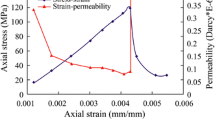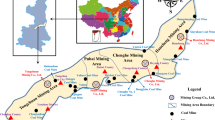Abstract
In terms of the problem that deep coal resources are under the threats of high water pressure, it is necessary to further study the outburst mechanism of working face floor karst water from the view of studying varying patterns of rock mechanical parameters and confined water pressure distribution of floor rock under the mining influence in the process of mining. Through the theoretical research of fluid-solid coupling and rock seepage experiment, the changing rule of the rock porosity and the Young’s modulus is analyzed, the changing law of the floor displacement is obtained by establishing the floor mechanic model, and the relation between elastic energy density and rock mass unit strain is established. Based on the numerical model of fluid-solid coupling analysis by the Comsol Multiphysics software, the changing law of floor displacement corresponds to the theoretical solution, the different variation laws of rock mass of different depths under the actions of ground pressure are acquired by simulation calculation, the distribution characteristics of pore water pressure are discussed, and the elastic energy density of the rock mass under the action of imbalance water pressure before and after mining is comparatively analyzed. Studies show that the distribution of pore water pressure is horizontally different before and after the stress peak line, and it mainly has four distribution patterns vertically. When mining above the confined water, the spatiotemporal position when and where the upper and lower boundaries of the rock mass in the lower water-resisting layer release energy at the same time is critical to the occurrence of water inrush.


















Similar content being viewed by others

References
A. de Swaan AO (1977) Analytical solutions for determining naturally fractured reservoir properties by well testing. J Society of Petroleum Engineers 16:117–122
Biot MA (1941) General theory of three-dimensional consolidation. Journal of Applied Physi 12:155–164
Cardiff M, Kitanidis PK (2008) Efficient solution of nonlinear, underdetermined inverse problems with a generalized PDE model. Comput Geosci 34:1480–1491
Dong S (2007) Current situation and prospect of coal mine geological guarantee technologies to improve safety and efficiency. J Coal Science and Technology 35(3):1–5
Eriksson, K D Estep, P Hansbo, C Johnson (1998) Computational differential equations. Cambridge University Press 368:376–378
Erkmen B (2008) Improving classification performance of sonar targets by applying general regression neural network with PCA. J Expert Systems with Applications 35:472–475
Falls SD, Young RP (1998) Acoustic emission and ultrasonic-velocity methods used to characterise the excavation disturbance associated with deep tunnels in hard rock. Tectonophysics 289:1–15
Hu W, Zhu K, Huang X (2010) Study on floor rock mass failure and water inrush caused by non-uniform distributed water pressure in mining face. J China Coal Soc 35:1109–1114
Hu W (2007) The depth effect of geological mechanics and hydraulic behaviors of rock mass. Journal of Coal Science and Engineering (China) 13:252–255
Jiang F (2008) Application of high-precision microseismic monitoring technique to water inrush monitoring in coal mine. Chin J Rock Mech Eng 27:1932–1938
José LB, Gonçalo TG (2014) Cylindrical excavations in clayey soils retained by jet grout walls: numerical analysis and parametric study considering the influence of consolidation. Comput Geotech 55:42–56
Kazemi H, Seth MS et al (1969) The interpretation of interference tests in naturally fractured reservoirs with uniform fracture distribution. J SPE Journal 9:463–472
Kitanidis PK (1995) Quasi-linear geostatistical theory for inversing. Water Resour Res 31:2411–2419
Liao X, Weiqun L, Zhanqing C (2004) Seepage theory in mining rock. Science of china press, M Beijing
Louis C (1974) Rock hydraulics in rock mechanics. Springer Verlag, M New York, pp. 299–387
Lu Y, Wang L (2015) Numerical simulation of mining-induced fracture evolution and water flow in coal seam floor above a confined aquifer. Comput Geotech 67:157–171
Majd FF, Nassiri P (2008) The evaluation of noise level in hand-held pneumatic tools (rock drill) by “pneurop cagi test code” method. J Canadian Acoustics-Acoustique Canadienne 36:48–49
Roza A, Behzad A-A, Craig TS (2014) Finite volume coupling strategies for the solution of a Biot consolidation model. Comput Geotech:494–505
Sakcali A, Yavuz H, Sahin S (2016) Quality assessment of natural stone blocks by an ultrasonic method. J Bulletin of Engineering Geology and the Environment 75:959–966
Selvadurai APS, Shi L (2015) Biot’s problem for a Biot material. Int J Eng Sci 97:133–147
Shi L (2009) Summary of research on mechanism of water-inrush from seam floor. Journal of Shandong University of Science and Technology 28:17–23
Shi L, Han J (2004) Floor water-inrush mechanism and prediction. China University of Mining and Technology Press, Jiangsu
Shi L, Mei Q, Wei W (2014) Water inrush evaluation of coal seam floor by integrating the water inrush coefficient and the information of water abundance. Int J Min Sci Technol 24:677–681
Solecki R, Conant RJ (2003) Advanced mechanics of materials. Oxford University Press, M London
Steffler ED, Epstein JS, Conley EG (2003) Energy partitioning for a crack under remote shear and compression. J Int J Fracture 120:563–580
Sujatha V, Kishen C (2003) Energy release rate due to friction at bi-material interface in dams. J Engng Fracture Mech 7:793–800
Sun P, Yang D, Chen Y (2007) Introduction to coupling models for multiphysics and numerical simulations. Science and technology of China press, M Beijing
Terzaghi K, Fröhlich OK (1936) Theorie der Setzung von Tonschichte. Deuticke, Leipzig
Tillman SM (1982) Determination of subcoal strata strength using ultrasonic testing. J Environmental & Engineering Geoscience 1:77–86
Wang HF (2000) Theory of linear poroelasticity with application to geomechanics and hydrogeology. Princeton University Press, Princeton
Wang Z, Hongquan L (1992) Mining above high water pressure aquifer. China Coal Industry Publishing House, M Beijing
Warren JE, Root PJ (1963) The behavior of naturally fractured reservoirs. J Society of Petroleum Engineering 3:245–255
Wu Q (2014) Progress, problems and prospects of prevention and control technology of mine water and reutilization in China. J China Coal Soc 5:795–805
Xie H, Yang J, Liyun L (2005) Criteria for strength and structural failure of rocks based on energy dissipation and energy release principles. Chin J Rock Mech Eng 17:3003–3010
Xie H, Zhonghui C (2004) Rock mechanics. Science Press, M Beijing
Yang T, Chunan T, Tan Z (2007) State of the art of inrush models in rock mass failure and developing trend for prediction and forecast of groundwater inrush. Chin J Rock Mech Eng 2:268–277
Yin, Liming (2011) Basic experimental study on water-inrush mechanism of floor in deep mining. D Shandong university of science and technology
Yin S, Zhang J, Demin L (2015) A study of mine water inrushes by measurements of in situ stress and rock failures. Nat Hazards 79:1961–1979
Zhang J (2005) Investigations of water inrushes from aquifers under coal seams. Int J Rock Mech Min Sci 42(3):350–360
Zhang Y (2014) Seepage field-strain field coupling analysis for rock masses of coal seam floor during mining based on COMSOL. J. Adv Mater Res 1010:1467–1470
Zhao Y, Feng Z, Yang D (2015) Three-dimensional fractal distribution of the number of rock-mass fracture surfaces and its simulation technology. Comput Geotech 65:136–146
Zhao Y, Zengchao F, Wan Z (2003) Least energy principle of dynamics failure of rock mass. J Chinese Journal of Rock Mechanics and Engineering 22:1781–1783
Zhu B, Wu Q, Yang J (2014) Study of pore pressure change during mining and its application on water inrush prevention: a numerical simulation case in Zhaogezhuang coal mine. Environmental Earth Sciences 71:2115–2132
Acknowledgements
This work was supported by the National Science Foundation of China (51404144). This study was supported by the Graduate student innovation fund of Shandong University of Science and Technology(NO.SDKDYC170205).
Author information
Authors and Affiliations
Corresponding author
Rights and permissions
About this article
Cite this article
Guo, W., Zhao, J., Yin, L. et al. Simulating research on pressure distribution of floor pore water based on fluid-solid coupling. Arab J Geosci 10, 5 (2017). https://doi.org/10.1007/s12517-016-2770-6
Received:
Accepted:
Published:
DOI: https://doi.org/10.1007/s12517-016-2770-6



